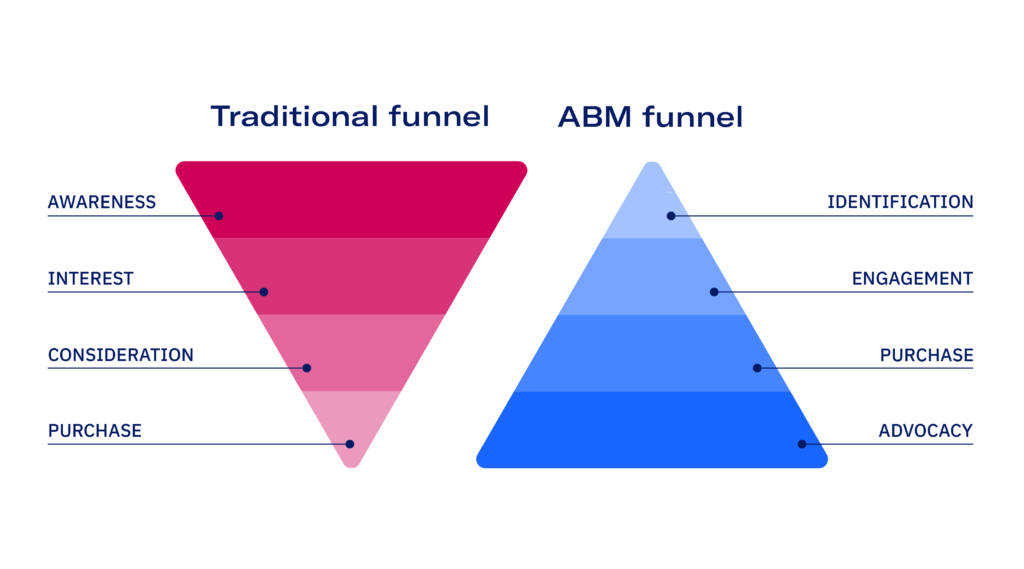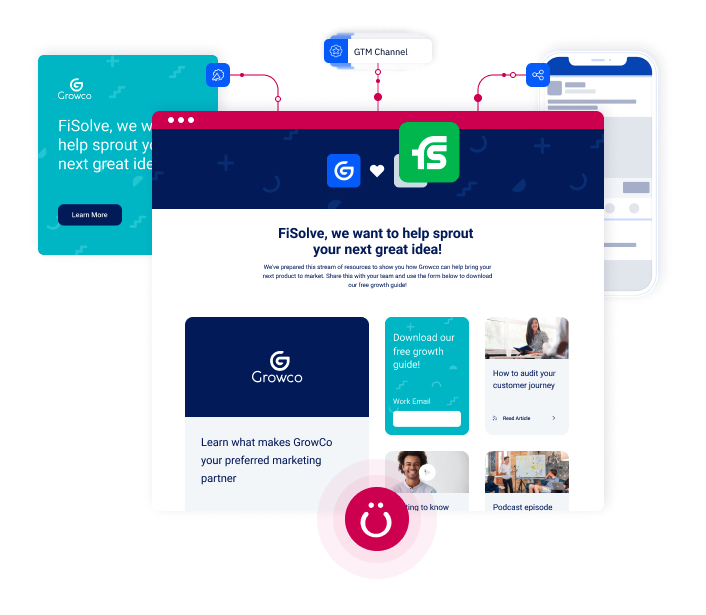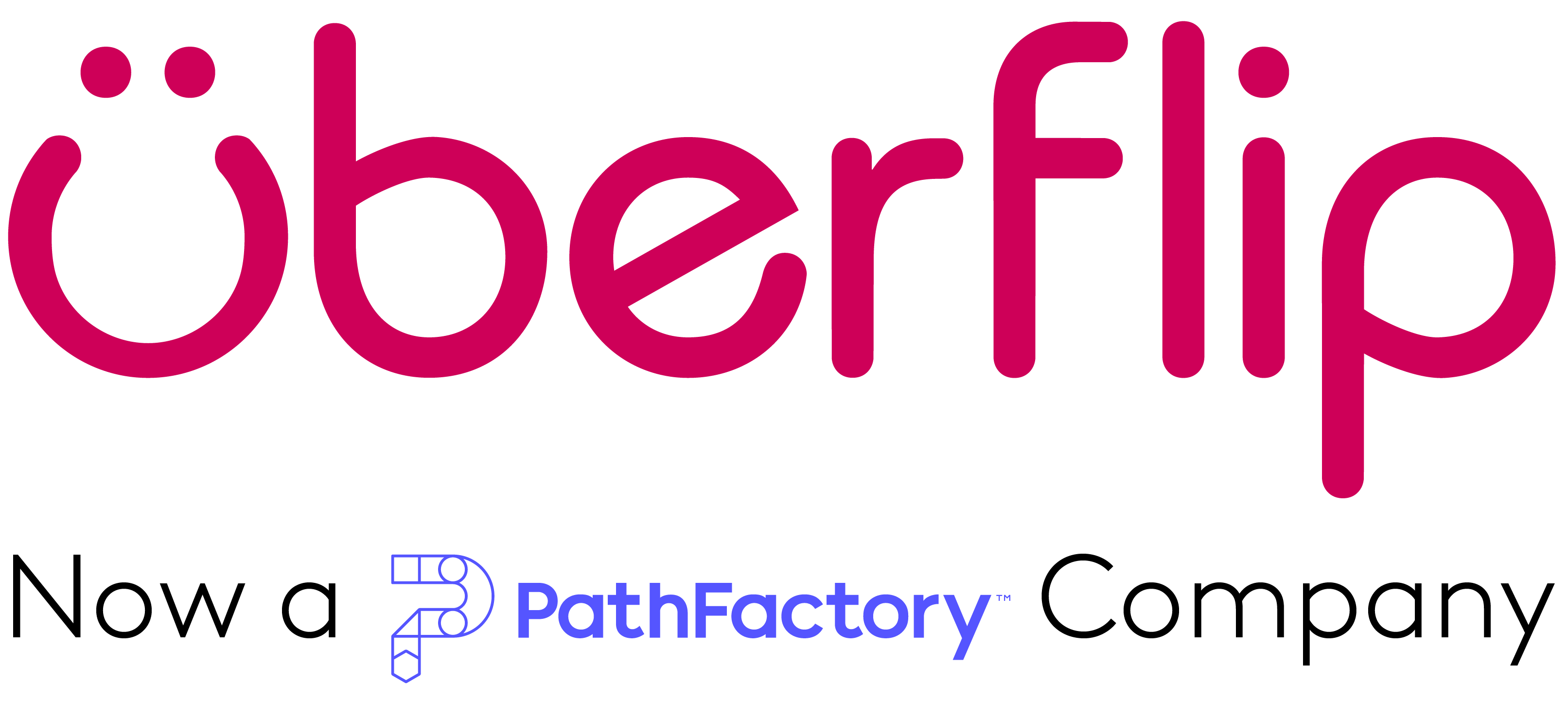In the early 2010s, many companies were growing frustrated with the old way of doing marketing, which often didn’t get results. Marketing and sales teams were often siloed, with marketing “throwing leads over the wall” to sales, without really thinking about what would happen next. And the truth is, not much usually did happen next—in 2013, Forrester Research reported that just 0.75% of B2B marketing leads ever converted to revenue. It was clear something had to change.
Enter account-based marketing. Unlike traditional marketing, which prioritizes outreach to a broad audience, ABM targets a narrow group of highly qualified accounts. Instead of putting out campaigns with the hope that interested buyers will find their own way into your funnel, ABM starts with identifying your most promising leads—then designing outreach specifically for them.
Since its inception, ABM adoption has only continued to grow. In this guide, we’ll break down exactly what ABM is, what makes it so compelling, and how to implement it into your demand generation strategy.
What is account-based marketing?
Account-based marketing (ABM) is a growth strategy that flips the traditional marketing funnel upside down. Rather than trying to reach a broad audience with generic messaging, sales and marketing collaborate together on a small number of high-value accounts to target with highly personalized outreach.
With ABM, you begin by identifying a small number of target accounts who fit your ideal customer persona. Then, you engage them with personalized outreach in the form of curated content, 1:1 video messages, email outreach, targeted ads, and more. Once internal champions are engaged, your sales and marketing teams can help equip them with the tools they need to influence decision-makers to approve a purchase.
Traditional vs. ABM funnel

Key components of account-based marketing
An ABM campaign can be a much more efficient way of using marketing and sales resources to achieve your common goal: revenue. And if you’re a marketing team who has ever struggled to show the impact of your activities on pipeline, this collaboration can make the value of your work much clearer.
Targeting high-value accounts
Engaging across channels
Personalizing experiences
Measuring what matters
Continuously optimizing
The benefits of account-based marketing
So what makes ABM such an effective strategy for generating demand? Let’s take a look at some of its concrete benefits.
1. Enhanced sales and marketing alignment
In the grand scheme of things, sales and marketing are really just two parts of the same go-to-market team. But in many businesses they’re siloed, which can lead to misalignment. For instance, maybe your marketing team produces a ton of great content, but sales doesn’t know how to leverage it, so it never gets used. With ABM, you could solve this by curating a selection of content for each audience, so sales knows precisely what pieces to share with which types of buyers.
2. Better reporting and analytics
The complexity of the B2B buyer’s journey can make it difficult to discern which campaigns and initiatives are working (or for your marketing team to get credit for conversions in your company’s attribution system). But by working with sales on ABM, you can better understand your impact on pipeline through direct reporting and analytics. You can then take the lessons learned from these experiments and apply them to other content and campaigns to better educate accounts during the buying process.
3. Increased ROI
ABM enables you to avoid random acts of marketing by focusing your time, energy, and budget on your highest-value leads. With ABM, you can directly tie your program spend to earned revenue. For instance, using a tool like Uberflip Analytics, you can track each visitor’s content consumption journey, as well as understand the individual performance of each piece of content—helping you link content to revenue. Over time, these insights allow you to optimize your content and programs around the most effective tactics to generate demand.
4. Shorter sales cycle
An ABM strategy supports the natural behavior of B2B buyers, who are spending more time than ever self-nurturing before contacting a salesperson. In fact, Gartner research finds that when B2B buyers are considering a purchase, they only spend 17% of that time meeting with potential suppliers—the rest of the time they’re researching independently or discussing with other stakeholders. By proactively identifying your best candidates and anticipating their needs, you not only save valuable time, you also make the buying process that much smoother for them.
5. Better retention and upsell rates
ABM allows you to speak directly to your customers with messaging that targets their unique pain points, at the moments they need to hear it. This personalized care and attention results in much better customer engagement—which translates into better retention and upsell rates.
Account-based marketing examples
Now you have a broad overview of the theory, but what does ABM look like in practice? Let’s break down some examples.
True 1:1 ABM

Traditional ABM has an “audience of one,” with highly customized messaging, uniquely tailored to each buyer. In this setup, each marketer or salesperson is responsible for a very small number of accounts and creates a personalized experience for each one. This is the most effective method, but it’s also highly labor-intensive, so it’s important to think carefully about which accounts are worth the investment of your time and resources.
Example: How Bri from Lev influenced over $1M in pipeline
In April 2021, Lev hosted their first virtual conference, Ultraviolet, in partnership with Salesforce and Cognizant. After the event, Lev’s sales and marketing teams worked together on a personalized, 1:1 content experience for one of their large target accounts who attended the event. They called it Ultraviolet After Show. By using Uberflip to help curate the content and hyper-personalize the experience, the team ensured everything in the content hub was relevant for that one high-value account.
1:Few ABM

While 1:1 ABM may be the most widely recognized method, it’s not the only kind of ABM program you can run. The 1:few approach uses the principles of ABM to create distinct audience segments, grouped by industry, buying persona, or funnel stage. It’s customized to each audience, but not unique to an individual account.
Example: How MaryJane From ContinuumCloud Increased Pipeline By 267% Using ABM
When Covid-19 struck, Continuum Cloud pivoted their in-person events strategy to a digital ABM program. After identifying accounts that were in-market using their intent data provider, they began to warm up their (at this time) cold audience with targeted ads and email nurture campaigns. They used CTAs from both of those channels to route directly to an Uberflip hub featuring some of their top-performing content—encouraging visitors to click around and binge pieces. Through Uberflip, they were able to customize the content by segment and audience, so that buyers would be served pieces that were most relevant to them.
1:Many ABM

Modern personalization technology has also enabled another kind of ABM—1:many ABM, or what’s sometimes referred to as “ABM at scale.” In this type of program, marketers still work with sales to identify account lists, only these lists can be much larger. Marketers then use personalization technology to target outreach that feels personal to a large number of accounts, without having to put in the manual effort to individually tailor it for each buyer or audience.
Example: How Amber From Degreed Generated $3.4M In Pipeline In Three Months
Leveraging the power of Uberflip, Degreed’s ABM Manager targeted their account list with general messaging on an ad served via LinkedIn or Terminus. The ad then drove accounts to an Uberflip destination where they could self-select the pain point that resonated best with them and choose to read more content associated with that pain point. With only $40K worth of campaign spend, she was able to drive $3.4M in pipeline.
Why personalization is so critical for ABM (and how to put it into practice)
The cornerstone of every great ABM campaign is personalization. Like peanut butter and jelly, personalization and ABM go hand-in-hand. If you want to target specific buyers, you have to create messaging that speaks directly to them and their pain points. If you want to personalize successfully, here are a few things to keep in mind.
1. Think beyond just the name
Personalization used to mean just putting someone’s name on a piece of content—but today it’s much more holistic. Now your audience expects the whole content experience to speak directly to the pains they’re trying to solve. To meet these needs, you’ll want to consider:
- Topics—what problems is this buyer facing? What topics are most aligned with their pain points?
- Industry examples—are there case studies or examples from this buyer’s industry (or similar ones?)
- Content formats—what types of content (blog posts, ebooks, videos, podcasts, etc.) does this buyer prefer to consume?
2. Tailor personalization to funnel stage
When you’re thinking about personalization, you want to consider not only who you’re speaking to, but where they’re at in their journey. For instance, it would be creepy to call someone by name or use other personally-identifying information at the top of the funnel, but if you don’t do this at the bottom of the funnel, your message won’t seem as genuine and might even get ignored. Consider how your relationship with your buyer is developing, and tailor your level of personalization accordingly.
3. Consider a personalization tool
Unless you’re dealing with a very small number of accounts (like in a true 1:1 ABM program), you’ll likely want to leverage technology to make it easier for you to personalize at scale. Automating personalization makes it easier for you to provide a tailored, white glove experience without having to manually create hundreds or thousands of personalized experiences. For instance, when you integrate your intent data provider with Uberflip, you can dynamically filter content based on who is visiting to automatically create a custom experience.
How to get started with ABM
Ready to try ABM for yourself? Here’s how you can integrate ABM into your marketing strategy in just five easy steps.
1. Set yourself up for success
When you set up your ABM strategy, take the time to lay the necessary foundations that are critical to success. For instance, a strong relationship with sales is critical. If marketing and sales have been siloed at your company for a long time, you may need to do some work to build up that relationship before embarking on an ABM program (or perhaps just try a small ABM experiment to start). You’ll also want to ensure you have enough leads, a plentiful supply of high-quality content, and the right tech stack to run your ABM program successfully.
2. Identify target accounts
To start an ABM campaign, you first need to figure out who you want to target. ABM is all about precision and personalization, so knowing who your potential buyers are is crucial. Your sales team may already have a good idea what those accounts are, or you may want to leverage an intent data provider to help identify promising accounts that are currently in-market.
3. Design your campaigns
Once you know who your buyers are, you can get to work designing messaging and campaigns that will speak directly to them. Depending on who your audience is and what kind of ABM you want to practice (1:1, 1:few, or 1:many), this can be as specific as building out a content experience custom-made for one specific account, or as general as setting up dynamic content filtering so the content experience automatically adapts to the person visiting.
4. Measure ROI
The most important part of implementing ABM is ensuring you can tie your marketing efforts to revenue. For this, you’ll want to ensure you’re aligned with sales to measure things like deal velocity, win/loss rates, and deal size. You may also want to measure some leading indicators to see how well accounts are engaging with your program, such as ad clicks, form fills, session duration in your content hub, and so on.
5. Refine and repeat
After you’ve been running your ABM program for a few months, check back in to see how things are working. How are your leading metrics (like engagement) and lagging metrics (like revenue) looking? Can you identify any gaps or areas of improvement in your program? Once you have a sense of what strategies are working well, you can continue to refine and optimize your program with each new cohort of target accounts.
Uberflip: Your must-have account-based marketing solution

Uberflip is rapidly becoming an essential content experience platform that allows ABM marketers to engage target audiences with relevant, personal content experiences. You can use Uberflip to spin up custom ABM landing pages without waiting on web developers or CMS requests, empower sales reps to quickly and easily build custom content experiences for prospects, and even dynamically personalize content hubs to unique visitors based on your audience intent data from a CRM or MAP.
With Uberflip, your customers get a relevant content experience that feels personalized just to them, helping them move more quickly through your funnel.

